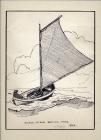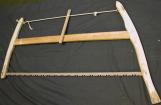14
PEN AND INK DRAWING OF DOUBLE ENDER 'SAILING FREE' By Joan Huestis Foster1990
Sunshine Coast Museum & Archives, Gibsons, British Columbia, Canada

15
When the Depression started many magazines folded and Evans lost his main source of income. He put aside his typewriter for hand tools in order to make himself a sturdy boat he could use for fishing. He chose a rowboat style that was very popular on the West Coast called the double-ender. The common feature of the boat was that both ends of the boat could part the waves similar to a canoe. A mast and sail could be added to help move the boat.16
REDRAWN PLANS OF THE GEORGIA STRAIT HAND TROLLER BUILT BY HUBERT EVANS C. 1932.1982
Sunshine Coast Museum & Archives, Gibsons, British Columbia, Canada

17
Hundreds of double-ender rowboats plied the waters of Georgia Strait between World War I and into the 1940's. The boat was adapted for the West Coast coastline and water conditions. Hubert Evans designed his boat to be fast, stable in the water and easy to row. The overall length was 14 feet 7 ¾ inches to ride between the waves. Redrawn plans of the Hubert Evans boat are available for sale at the Sunshine Coast Museum and Archives, PO Box 766, Gibsons, B.C. Canada V0N 1V0, or call (604-886-8232).18
REDRAWN PLANS FOR OARS AND CROSS SECTION OF HUBERT EVANS GEORGIA STRAIT HAND TROLLER C. 1932.1982
Sunshine Coast Museum & Archives, Gibsons, British Columbia, Canada

19
The method of construction was called "carvel planked". The edge of one steamed and bent plank was butted up to the edge of another plank and then caulked to provide a waterproof seam.20
BUCKSAW - Example of handtools used in local boat building.1930
Sunshine Coast Museum & Archives, Gibsons, British Columbia, Canada

21
Whether for boat building or house building, a rack was built to hold the logs so that they could be sawed one plank at a time from the log.23
Before he could build his boat, Evans had to build a boathouse. The boathouse provided shelter from the winter storms and a source of heat for the steam box. The steam box was a large box big enough to accommodate the planks for the hull and the ribs of the boat. Each plank and rib was made by hand and then steamed and bent into the appropriate shape. The boathouse is still located on the Evans property. The large glass window below the chimney has replaced the steam box.24
HUBERT EVANS DOUBLE ENDER C. 19321932
Sunshine Coast Museum & Archives, Gibsons, British Columbia, Canada

25
Evans' boat was built for transportation and recreation but its main purpose was for fishing. The double-ender design incorporated the needs of someone who was going to travel over long stretches of water in the course of a day. The boat design was known for its stability, speed, seaworthiness, ease of rowing, quietness in the water and for its ease of getting on and off the beach in any weather. For fishing, it was typically a one-person boat.26
STRING SEAT FROM HUBERT EVANS' DOUBLE ENDER C. 19321932
Sunshine Coast Museum & Archives, Gibsons, British Columbia, Canada

